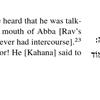2: Talmud excerpt, “This, too, is Torah, and I must learn,” Aramaic with English translation, ca. 500 CE.
This notorious excerpt from Berakhot (“Brokhes,” in Ashkenazic pronunciation), the first tractate of the Talmud, presents a situation remarkably similar to one in Peretz’s story. Here, a curious young student hides out under the bed of an esteemed rabbi to investigate the latter’s activities, just as Peretz’s protagonist does in the prior excerpt. In the Talmud, the situation is overtly sexual, while in the latter, it is perhaps only hinted at humorously. (In addition to the clear parallels between the two stories, note also that the protagonist in the relevant excerpt of Peretz is studying Talmud from memory, while emulating a situation found in the Talmud.)
Suggested Activity: Read through the excerpt with students. If someone is able to read the Aramaic, ask them to read it aloud for the class. Begin by asking students what basic parallels they find in the two excerpts. What details of the two situations are alike? Ask them what characteristics they may find in the student, Rav Kahana, and if they are similar to how the Litvak is stereotyped in the story. Do you think Peretz is alluding to this story in his tale, and to what end? (You might wish to inform students that Peretz was afforded private tutelage in the Talmud by his Orthodox Jewish parents, and also privately read secular literature in Hebrew, Russian, German, Polish, and French.) How does he add to it, and to the Jewish tradition of academic inquiry for the sake of inquiry, with the conclusion that the protagonist ultimately comes to (the story’s moral)?
Sources: Babylonian Talmud Berakhot 62a, in The William Davidson Talmud, source sheet compiled on Sefaria, https://www.sefaria.org/Berakhot.62a.2?lang=bi&with=all&lang2=en, accessed January 20, 2020.
Babylonian Talmud Berakhot 62a, from Daniel Boyarin, “Women’s Bodies and the Rise of the Rabbis: The Case of Sotah,” in Jews and Gender: The Challenge to Hierarchy (Studies in Contemporary Jewry: An Annual, vol. XVI), ed. Jonathan Frankel (New York: Oxford University Press, 2000), 94, 99.

